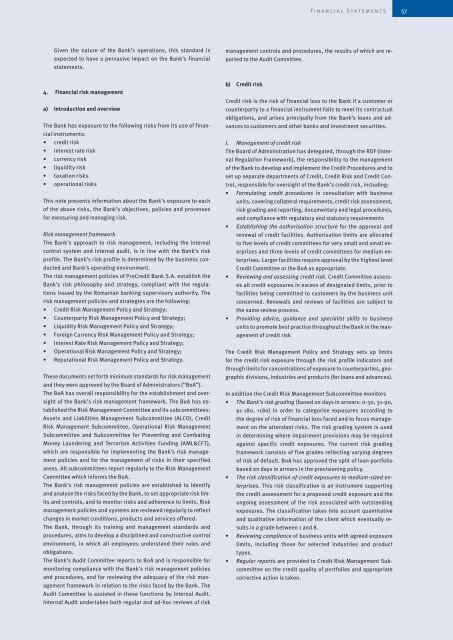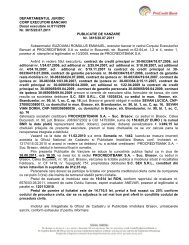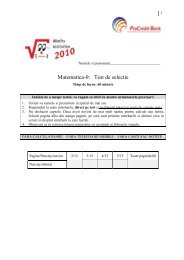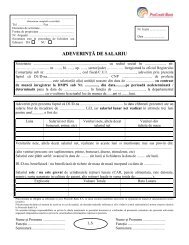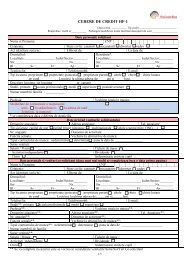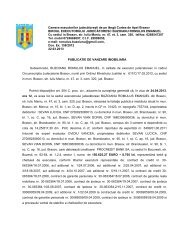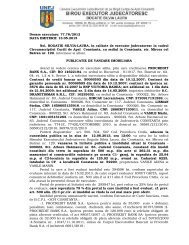Annual Report 2010 - ProCredit Bank
Annual Report 2010 - ProCredit Bank
Annual Report 2010 - ProCredit Bank
You also want an ePaper? Increase the reach of your titles
YUMPU automatically turns print PDFs into web optimized ePapers that Google loves.
Given the nature of the <strong>Bank</strong>’s operations, this standard is<br />
expected to have a pervasive impact on the <strong>Bank</strong>’s financial<br />
statements.<br />
4. Financial risk management<br />
a) Introduction and overview<br />
The <strong>Bank</strong> has exposure to the following risks from its use of financial<br />
instruments:<br />
• credit risk<br />
• interest rate risk<br />
• currency risk<br />
• liquidity risk<br />
• taxation risks<br />
• operational risks<br />
This note presents information about the <strong>Bank</strong>’s exposure to each<br />
of the above risks, the <strong>Bank</strong>’s objectives, policies and processes<br />
for measuring and managing risk.<br />
Risk management framework<br />
The <strong>Bank</strong>’s approach to risk management, including the internal<br />
control system and internal audit, is in line with the <strong>Bank</strong>’s risk<br />
profile. The <strong>Bank</strong>’s risk profile is determined by the business conducted<br />
and <strong>Bank</strong>’s operating environment.<br />
The risk management policies of <strong>ProCredit</strong> <strong>Bank</strong> S.A. establish the<br />
<strong>Bank</strong>’s risk philosophy and strategy, compliant with the regulations<br />
issued by the Romanian banking supervisory authority. The<br />
risk management policies and strategies are the following:<br />
• Credit Risk Management Policy and Strategy;<br />
• Counterparty Risk Management Policy and Strategy;<br />
• Liquidity Risk Management Policy and Strategy;<br />
• Foreign Currency Risk Management Policy and Strategy;<br />
• Interest Rate Risk Management Policy and Strategy;<br />
• Operational Risk Management Policy and Strategy;<br />
• Reputational Risk Management Policy and Strategy.<br />
These documents set forth minimum standards for risk management<br />
and they were approved by the Board of Administrators (“BoA”).<br />
The BoA has overall responsibility for the establishment and oversight<br />
of the <strong>Bank</strong>’s risk management framework. The BoA has established<br />
the Risk Management Committee and its subcommittees:<br />
Assets and Liabilities Management Subcommittee (ALCO), Credit<br />
Risk Management Subcommittee, Operational Risk Management<br />
Subcommittee and Subcommittee for Preventing and Combating<br />
Money Laundering and Terrorism Activities Funding (AML&CFT),<br />
which are responsible for implementing the <strong>Bank</strong>’s risk management<br />
policies and for the management of risks in their specified<br />
areas. All subcommittees report regularly to the Risk Management<br />
Committee which informs the BoA.<br />
The <strong>Bank</strong>’s risk management policies are established to identify<br />
and analyse the risks faced by the <strong>Bank</strong>, to set appropriate risk limits<br />
and controls, and to monitor risks and adherence to limits. Risk<br />
management policies and systems are reviewed regularly to reflect<br />
changes in market conditions, products and services offered.<br />
The <strong>Bank</strong>, through its training and management standards and<br />
procedures, aims to develop a disciplined and constructive control<br />
environment, in which all employees understand their roles and<br />
obligations.<br />
The <strong>Bank</strong>’s Audit Committee reports to BoA and is responsible for<br />
monitoring compliance with the <strong>Bank</strong>’s risk management policies<br />
and procedures, and for reviewing the adequacy of the risk management<br />
framework in relation to the risks faced by the <strong>Bank</strong>. The<br />
Audit Committee is assisted in these functions by Internal Audit.<br />
Internal Audit undertakes both regular and ad-hoc reviews of risk<br />
management controls and procedures, the results of which are reported<br />
to the Audit Committee.<br />
b) Credit risk<br />
Financial Statements 57<br />
Credit risk is the risk of financial loss to the <strong>Bank</strong> if a customer or<br />
counterparty to a financial instrument fails to meet its contractual<br />
obligations, and arises principally from the <strong>Bank</strong>’s loans and advances<br />
to customers and other banks and investment securities.<br />
i. Management of credit risk<br />
The Board of Administration has delegated, through the ROF (Internal<br />
Regulation Framework), the responsibility to the management<br />
of the <strong>Bank</strong> to develop and implement the Credit Procedures and to<br />
set up separate departments of Credit, Credit Risk and Credit Control,<br />
responsible for oversight of the <strong>Bank</strong>’s credit risk, including:<br />
• Formulating credit procedures in consultation with business<br />
units, covering collateral requirements, credit risk assessment,<br />
risk grading and reporting, documentary and legal procedures,<br />
and compliance with regulatory and statutory requirements<br />
• Establishing the authorisation structure for the approval and<br />
renewal of credit facilities. Authorisation limits are allocated<br />
to five levels of credit committees for very small and small enerprises<br />
and three levels of credit committees for medium enterprises.<br />
Larger facilities require approval by the highest level<br />
Credit Committee or the BoA as appropriate.<br />
• Reviewing and assessing credit risk. Credit Committee assesses<br />
all credit exposures in excess of designated limits, prior to<br />
facilities being committed to customers by the business unit<br />
concerned. Renewals and reviews of facilities are subject to<br />
the same review process.<br />
• Providing advice, guidance and specialist skills to business<br />
units to promote best practice throughout the <strong>Bank</strong> in the management<br />
of credit risk<br />
The Credit Risk Management Policy and Strategy sets up limits<br />
for the credit risk exposure through the risk profile indicators and<br />
through limits for concentrations of exposure to counterparties, geographic<br />
divisions, industries and products (for loans and advances).<br />
In addition the Credit Risk Management Subcommittee monitors<br />
• The <strong>Bank</strong>’s risk grading (based on days in arrears: 0-30, 31-90,<br />
91-180, >180) in order to categorise exposures according to<br />
the degree of risk of financial loss faced and to focus management<br />
on the attendant risks. The risk grading system is used<br />
in determining where impairment provisions may be required<br />
against specific credit exposures. The current risk grading<br />
framework consists of five grades reflecting varying degrees<br />
of risk of default. BoA has approved the split of loan portfolio<br />
based on days in arrears in the provisioning policy.<br />
• The risk classification of credit exposures to medium-sized enterprises.<br />
This risk classification is an instrument supporting<br />
the credit assessment for a proposed credit exposure and the<br />
ongoing assessment of the risk associated with outstanding<br />
exposures. The classification takes into account quantitative<br />
and qualitative information of the client which eventually results<br />
in a grade between 1 and 8.<br />
• Reviewing compliance of business units with agreed exposure<br />
limits, including those for selected industries and product<br />
types.<br />
• Regular reports are provided to Credit Risk Management Subcommittee<br />
on the credit quality of portfolios and appropriate<br />
corrective action is taken.


